
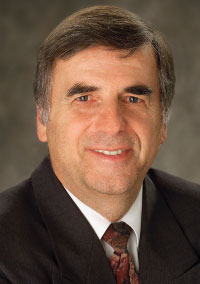 |
| Richard Paquette, CEO of Victoria International, led the field in airport SMS. |
It was a long time in the making but on January 1, 2008, Canada formally instituted Safety Management Systems (SMS) for airports.
The airport SMS story began in earnest in 2003, with the ICAO Standard requiring certification of aerodromes and implementation of SMS effective November 2006. Concurrently, Canada developed national measures to implement the ICAO Standards and on December 26, 2007, new Canadian Aviation Regulations (CARs) were gazetted, requiring airports to implement SMS.
So, is it “all change?” Not quite – most airports already have a range of safety procedures in place and new initiatives in airport operations don’t happen overnight. The difference is the adoption of a systematic process, based on a Transport Canada (TC) framework. The regulations, based on a four-phase implementation schedule, apply immediately to the ten international airports in the schedule to the CARs, and to other airports from January 2009.
However, some airport managers bit the bullet and got a head start preparing for the new system. Richard Paquette, CEO of Victoria International Airport, started the ball rolling in 2005. By 2006, Victoria International had its SMS up and running with a Gap Analysis, Hazard and Risk Analysis, Safety Management Manual and some training already completed. Victoria was quickly followed by Kelowna, Gander, Abbotsford and Calgary to name just four.
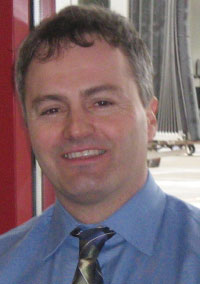 |
| Mike Pastro, general manager of Abbotsford International Airport. |
The Abbotsford initiative is particularly significant. Not only is Abbotsford (YXX) one of the busiest flight training airports in Canada, but posts steady increases in scheduled traffic (508,464 pax and 175,405 movements in 2007) and is home to the Abbotsford International Air Show. Led by operations manager Carman Hendry, YXX completed preparations for implementation of the new SMS regulations in mid-January 2008, 12 months ahead of the regulatory deadline. Supported by airport general manager Mike Pastro and the Airport Authority Board, Hendry undertook SMS implementation in a textbook operation, in line with CARs requirements and the processes developed by TC. Hendry undertook specialised SMS training in 2006, and in 2007 the City of Abbotsford selected QualaTech Aero Consulting to assist in implementing the airport SMS. Hendry steered the airport through the recommended TC process, from a detailed Gap Analysis, followed by a Project Plan, to Hazard Identification and Risk Analysis, training and preparation of the Safety Management Manual. A unique aspect of the Abbotsford approach was establishment of a Risk Assessment Team, composed of managers and airside employees. The team received specialized training and provides a focus for risk assessment activities. In addition, all airside employees received the safety-oriented human factors training, required by CARs, plus basic safety management training.
Adoption of SMS in Canada followed an intensive consultation process with the airport industry, during which many opinions surfaced – not all of them supportive of either the ICAO or TC initiatives. However, what seems to have resulted is a common sense approach to ensuring that the airports are increasingly proactive toward their major role – namely, ensuring the safety of operations and mitigating all possible risks of accidents or incidents. TC has published airport SMS implementation procedures in Advisory Circular 300-002.
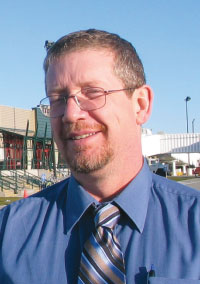
|
| Carman Hendry, operations manager at Abbotsford International Airport. |
Is this overregulation? Absolutely not. The whole thrust of SMS in ICAO, airlines, airports, air traffic services and all the supporting functions, is that it is proactive and based on a strong corporate safety culture. It is all about airports and others, taking the initiative to prove that their operations are safe and answering the questions “do they say what they do” and “do they do what they say.” The latter is echoed by veteran Vancouver International Airport safety manager Dave Larrigan, now an independent consultant. As he puts it – “in principle, safety management is not new; what is new is the structured and documented approach.”
Larrigan believes that the phased approach to implementation makes sense and should help airports to develop an SMS that not only complies with CARs but meets their needs according to their circumstances. He emphasises the different challenges facing airports compared with air carriers. The problem for the airport “accountable executive” he says, is that he or she is not the employer of most of the airside personnel. “The accountable executive is more like a mayor of a small city, providing operational facilities, utilities and accommodation for tenants and travellers – but does not have an employer/employee relationship with the majority of those who are expected to follow the safety procedures.”
In 2006, Kelowna International Airport – 10th busiest in Canada – was experiencing spectacular traffic growth and the need for infrastructure development. Determined to get ahead of the curve, airport general manager Roger Sellick assigned the task of SMS implementation to fire and security chief Neil Drachenberg and operations AGM Dave Fuller. As at Victoria and Abbotsford, Kelowna undertook a structured process, working with consultants and starting with a Gap Analysis. “Kelowna has put a lot of work into training employees for SMS,” says Drachenberg, “and is prepared for a TC SMS Audit.” Drachenberg echoes Victoria’s Paquette, noting that implementation of SMS has not had a major effect on resources while the upgrading and improvement of policy, procedures and infrastructure to reflect a safer operational environment, are seen as benefits.
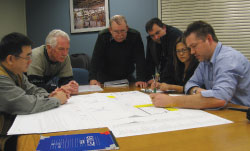 |
| The Abbotsford Risk Assessment Team at work. (Photo courtesy of David Olsen) |
Gander International Airport faced particular challenges with the introduction of SMS, but was ready with its safety management manual and well-documented procedures by the time the amended CARs were published. Gander has a proud history as a cornerstone of North Atlantic aviation and although transatlantic scheduled traffic no longer lands at Gander, the airport is often a hive of activity, handling state and military aircraft of many nations. Furthermore, it is a vital diversion facility – as demonstrated by 9/11 – and frequently receives aircraft with a wide variety of problems from technical faults to medical emergencies. The irregular and varied nature of operations at Gander, frequently during severe weather, combined with economic pressures and stretched resources, make SMS both an essential tool and an implementation challenge.
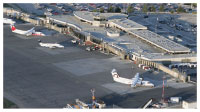 |
| Kelowna International Airport is Canada’s 10th busiest airport. |
At Victoria International, Canada’s 9th busiest airport, Paquette emphasizes that although SMS has been fully implemented, “it does not mean that we are finished – the framework is in place but we will continue to refine and improve the system.” With the system working and well documented in the SMS Manual, Paquette reports that it took about one-person year for implementation, half that effort for ongoing management, and some consultant effort to produce the SMS Manual. Paquette stresses that safety was always a priority at Victoria International but it is now managed systematically – which involved reorganization and additional activities. He believes that SMS has made Victoria International an even safer airport, and is ready for the first TC SMS Audit.
Back at Abbotsford, Mike Pastro points to the strong buy-in by the Airport Authority Board, prudent and effective use of qualified consultants, and good communication with employees that has created a strong safety culture and a hands-on functional SMS.
Pastro and Hendry see the airport SMS not as an imposition but as a business benefit and a means to manage risk. This will help YXX to not only manage risks at an increasingly busy airport but to continue successful management of the Air Show, when hundreds of thousands of people, large numbers of high-performance aircraft and a multitude of support teams descend on the airport every August.
Meanwhile in Canada’s heartland, Regina International Airport VP of operations Steve Burchi is reviewing the CARs requirements and plans to start an SMS implementation project in 2008.
Vancouver International is Canada’s second busiest airport, handling over 16 million passengers annually, and Paul Levy, VP airside operations, started planning for SMS in 2007. He is upbeat about SMS implementation, emphasising that “both the airport industry and Transport Canada will learn a great deal as we work together to identify and achieve the expected benefits of SMS.” Furthermore, he makes the point that although the YVR safety record demonstrates a solid existing safety management program and safety culture, SMS is a new approach to safety, which he says “will place all certificate holders on common ground, with a common language for safety management.” Asked about the benefit to airlines and passengers, Levy stresses that the most significant and measurable benefits from SMS will accrue as organizational systems mature and safety data is shared between certificate holders across the entire aviation industry, enabling it to identify and respond to risks in a more timely fashion.
Paul Van den Eynden, SMS Director at Calgary International Airport, with over 12 million passengers annually, displays the confidence in SMS common to many airports in western Canada. Says Van den Eynden: “We meet all requirements for initial certification, and our Gap Analysis confirmed we already have most SMS elements in place.” He emphasizes that the key to the readiness for a TC-regulated SMS was the appointment of the SMS Implementation project manager in 2005, upgraded to director SMS, in 2006. Like Carman Hendry at Abbotsford, Van den Eynden sees SMS as a cornerstone of good business practice, enhancing airport safety and protecting airport users. All the SMS leaders focus on training and Calgary is no exception, with Safety and Emergency Preparedness, SMS and Human Factors training programs.
How is Canada doing internationally? Although the UK, European Union and Australia took a number of early SMS initiatives, on a world scale Canada is doing pretty well in keeping up with its ICAO obligations. A documented and regulated program is now in place, but in large areas of the world, lack of implementation is an issue, and this is where accidents are a continuing problem. However, none of us can be complacent – we still have airport accidents in Canada – and those airports and managers that have seized the initiative are good examples of what can be done, even in the face of resource difficulties.
Recently, the UK Health and Safety Executive reported that the airport apron had overtaken the construction site as the most perilous of all industry workplaces. This sparked off a good deal of controversy, with many airside managers claiming that airside handling companies have higher standards than the construction industry. Nevertheless, the mix of high-energy aircraft, vehicles and people introduces the kind of hazards that motivated the early implementation of SMS by Victoria, Kelowna, Calgary and Abbotsford.
IATA, which already has a successful airline operational safety audit program, has introduced the Safety Audit for Ground Operations (ISAGO) program that will audit ground handlers to a common set of standards. Vancouver International was one of the sites used for the ISAGO trial audits and management is convinced of its merits.
So, is it worth getting really serious about SMS? QualaTech consultants Keith Green and John Barnett have no doubts. As proof, they point to the Flight Safety Foundation report, reprinted in TC’s January 2007 Aviation Safety Letter.
TC stressed that ramp personnel work in a noisy environment, in all weather and light conditions, in day and night. They are under pressure to complete often physically demanding tasks within a tight time frame, often with limited communication with other groups involved in ramp operations, such as pilots, fuel handlers, customer service agents, etc.
TC pointed out that existing data paints a regrettable picture and when compared to other industries, the scheduled air transport industry is not doing well in terms of safety incidents. In 1998 US industrial safety statistics, the lost-workday incidence rate per 100 employees showed an average of 3.2 for the construction industry, considered to be a high-risk workplace, and a staggering 8.2 for the scheduled air transport sector. U.S. data for 2004 showed a rate of 8.0 lost workdays per 100 employees. Thus, TC emphasized, although the aviation industry had seen large increases in productivity, the advent of new technology aircraft, and new airlines, there had been “absolutely no significant improvement in injury rates”!
The SMS is our safety net – let’s use it!
David Olsen is an aviation consultant, based in Victoria, BC, whose 49-year career includes extensive expeience in airports, CNS/ATM systems, safety and training. He can be reached at olsendj@shaw.ca .